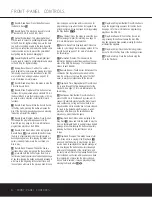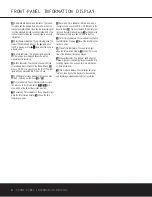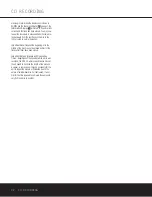
CD RECORDING
CD RECORDING 19
Making recordings on the CDR 26 is simple and easy
once you become accustomed to the basics of CD
recording. Before making your first recording, please
take a moment to review the CD Recording Basics on
page 14. In particular, you will need to become famil-
iar with the types of discs that may or may not be
used in the CDR 26. In addition, some terms used in
the following pages may be new to you. The following
definitions and information will help you to make CD
recordings using the CDR 26’s many features:
•
The CDR 26 accepts analog inputs and digital
coax or optical inputs. Before making a recording,
be certain that you have selected the correct input.
(See page 20.)
•
After a disc is recorded, it must be finalized. This
process adds Table of Contents data to the disc and
makes it playable on other machines. Until a disc is
properly finalized, it may not be played on standard
CD players or in the
Play Deck
3
of the CDR 26.
(See page 21.)
•
The CDR 26 may record on either CD-R or
CD-RW discs, but they must be of the type specifi-
cally designed for use in consumer-audio CD
recorders. These discs may be recognized by look-
ing for the words “Digital Audio” in the compact disc
logo on the blank disc or its packaging. Discs with
the logo reading only “Compact Disc/Recordable”
are designed for computer data recording, and they
will NOT work in the CDR 26. (See page 14.)
•
CD-R discs may not be erased or have material
added to them once they have been finalized.
•
At least four seconds of blank recording time must
remain on an unfinalized disc for recording to take
place.
•
The maximum number of tracks that may be
recorded on a disc is 99.
• Some CD-R/CD-RW audio recording discs may be
used for single-speed recordings only. If you use a
disc with such a warning, make certain not to make
a dub at x2 or x4 speed. However, the CDR 26 has
been tested for compatibility with a wide range of
blank discs from manufacturers throughout the
world. In most cases, blank discs will produce high-
quality recordings at any dub speed.
• In some rare cases, a CD player may not be com-
patible with CD-R discs. If you find that a CD-R disc
plays in some players but not in others, the fault is
most likely with the player, not with the recorded
disc or the CDR 26. Remember that CD-RW discs
made in the CDR 26 will play only in CD players that
are specially designed to accommodate CD-RW
discs. Most DVD players are compatible with final-
ized CD-RW discs.
•
Some commercial CD discs may contain a copy-
protection data bit that will prevent a digital copy of
the disc to be dubbed. In that case, the CDR 26 will
attempt to make an analog dub.
•
This product is equipped with the Serial Copy
Management System (SCMS) to protect the rights of
copyright owners. Although it is possible to make a
copy of most CDs for your own personal use, it is
not possible to make a digital copy from another
digital copy, but it is possible to make an analog
copy of a digital copy.
RECORDINGS MAY BE MADE FOR
PERSONAL USE ONLY. ANY UNAUTHO-
RIZED COPYING IS SUBJECT TO THE
APPLICABLE LAW.
•
The CDR 26 will not copy DVD discs, computer-data
discs, CD-based computer or video game discs, or
digital audio discs with a sample rate that is not
compatible with the range of the CDR 26’s sample-
rate converter.
Recordings on the CDR 26 may be made in a num-
ber of ways:
•
Discs or single tracks may be dubbed using the
playback deck on the CDR 26 as a source. These
copies may be made in real time, at twice normal
speed, or at four times normal playback speed.
•
Recordings may be made from an external CD
player or other digital source that is synchronized
with the dub being made in the CDR 26.
•
Recordings may be made from any compatible
external digital source.
•
Recordings may be made from an external analog
source.
• You may record a compilation or mix of tracks from
one or more CDs by dubbing from the CDR 26’s
playback deck.
NOTE:
CD-RW discs may not be erased and reused
more than 99 times. This is a limitation of the CD-RW
format, not a fault of the CDR 26.
Disc Dubbing
The easiest way to make a copy of an entire disc is to
use the CDR 26’s internal dub capability.
Step One:
Insert a blank or unformatted disc in the
Record Drawer
%
. When the disc is inserted, the
CDR 26 will examine it to determine whether it is a
CD-R or CD-RW disc, and optimize itself for the best
possible recording. This is indicated by an
OPC
message in the
Information Display
Y
.
Step Two:
Place the disc to be dubbed in the
Play
Deck
3
and wait until the Table of Contents data is
read and the
Information Display
Y
shows the
track and running time data for the disc.
Step Three:
Select a dub speed. The default speed
is a real-time dub, where the recording takes as long
as the actual running time of the disc. However, with
the CDR 26 you may also select x2 dubbing or x4
dubbing. Press the
Speed Button
)q
to select a
speed as indicated by the
x2/x4 Indicators
K
.
When no Speed Indicator lights, the unit is set to real-
time recording. The slower the record-dub speed, the
more tolerant the unit is of errors on the blank disc.
However, with most high-quality blank discs, the x2
and x4 speeds should not present a problem.
Step Four:
Make certain that there is sufficient blank
space on the record disc. To do this, first determine
the time available on the blank disc by subtracting the
time of previously recorded material, if any, that is
shown in the record-side
Information Display
Y
from the total time available on the disc. That number
should be greater than the total time of the disc to be
dubbed, which is shown in the play-side
Information
Display
Y
.
Step Five:
When you are ready to start the dub,
press the
Dubbing Button
9l
. During this
process the
Dubbing Indicator
M
will light, the
Record Indicator
P
will flash and a
BUSY
message will flash in the record deck’s
Information
Display
Y
.
Step Six:
When both Information Display indicators
return to normal, with indications of
01 00:00
,
press the
Play/Select Button
Ó
j
to start
the dub.
While the dub is in progress, you will see the track
numbers and running time increase as the disc is
copied. The Level Indicators will also flash but this is
only for your reference, as record levels may not be
adjusted during digital recordings. It is possible to lis-
ten to the source disc while it is being dubbed by
selecting the appropriate input on your receiver, pre-
amp or processor.
Important Note:
When a high-speed (x2 or x4) dub
is being made, you will hear the playback from the
outputs
¡£§
at the faster speed. Fast-speed
playback increases the pitch of a sound, and when
played back at high volume levels this may damage
your speakers. DO NOT use high volume levels
when listening to high-speed dubs while they are
in progress.
The dub will stop automatically when the source disc
has played through to the end. If you are adding addi-
tional tracks to a disc that has not yet been finalized,
UPDATE
will flash in the
Information Display
Y
. After the dub is finished, the CDR 26 will return to
normal operation. To manually stop a dubbing opera-
35
Содержание CDR 26
Страница 27: ......























